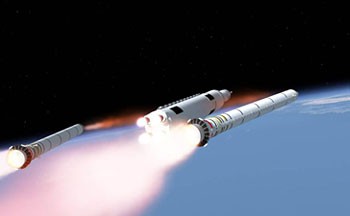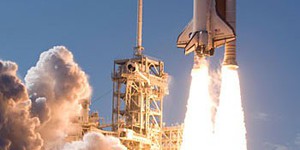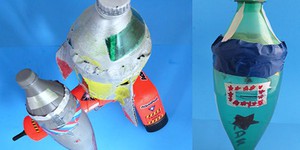Summary
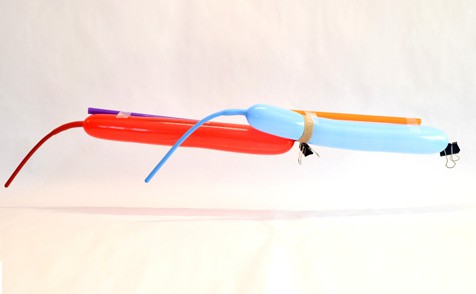 Image Credit: Ben Finio, Science Buddies / Science Buddies
Image Credit: Ben Finio, Science Buddies / Science Buddies
Introduction
If you have ever watched a rocket launch on TV, you might have noticed that rockets have multiple stages. Some parts of the rocket fall off and burn up in the atmosphere whereas the rest of the rocket keeps going. Why does this happen? Try this activity to find out and build your own two-stage rocket using balloons!
Materials
- Two modeling balloons (These are the long, skinny kind used to make balloon animals, not the round kind.)
- Two straws
- Two large binder clips
- Paper towel tube
- Fishing line or string (A fishing line will generally work better because it has lower friction.)
- Scissors
- Clear or masking tape
- One other person to help set up the rocket
- Balloon pump, to make it easier to inflate the balloon (optional)
- Two sturdy pieces of furniture across the room from each other (to which you can tie your fishing line or string)—The farther, the better!
- Open space where you can set up the activity
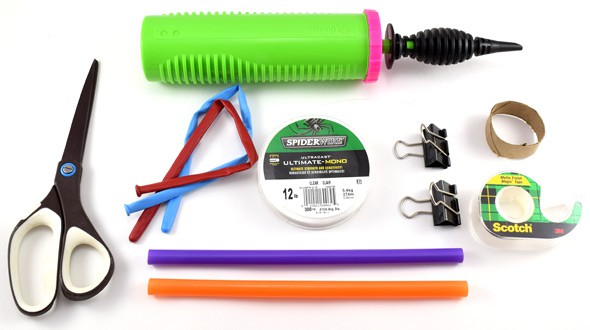 Image Credit: Ben Finio, Science Buddies / Science Buddies
Image Credit: Ben Finio, Science Buddies / Science Buddies
Prep Work
- Fishing line can be hard to see—make sure you warn other people that you are doing this project, so they don't walk into the line.
- Thread the fishing line through the two straws.
- Tie the ends of the fishing line to two sturdy pieces of furniture and make sure it is pulled tight. The longer you can make the line, the better.
- Cut a small ring (less than one inch long) from the cardboard tube.
- Stretch the balloons to loosen them before inflating.
Instructions
- Inflate the first balloon about three quarters full. Have your helper pinch the balloon's nozzle shut, but do not tie it. Optionally, you can use a binder clip to pinch the nozzle and prevent the balloon from deflating.
- Pull the first balloon's nozzle through the cardboard ring and press it up against the side. Make sure you do not let the balloon deflate.
- Thread the second balloon partially through the cardboard ring, so its nozzle is facing the same direction as the first balloon.
- Carefully inflate the second balloon about three quarters full. Your goal is to inflate the balloon such that it presses up against the inside of the cardboard ring, and squeezes the nozzle of the first balloon shut. This can take some practice—be patient! It will be much easier if you have one person hold on to the cardboard ring and the first balloon while another person inflates the second balloon. If you do this perfectly, you should be able to release the nozzle of the first balloon without deflating it. If you have trouble, you can keep the first balloon's nozzle pinched shut for now.
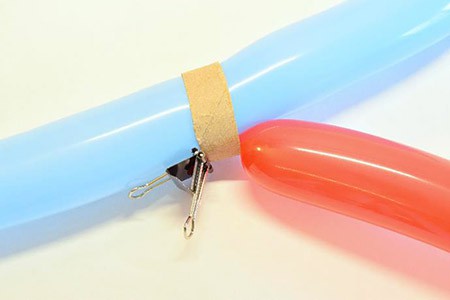 Image Credit: Ben Finio, Science Buddies / Science Buddies
Image Credit: Ben Finio, Science Buddies / Science Buddies
- Keep the nozzle of the second balloon pinched shut, either with your fingers or a binder clip.
 Image Credit: Ben Finio, Science Buddies / Science Buddies
Image Credit: Ben Finio, Science Buddies / Science Buddies
- Tape the balloons to the drinking straws, with the balloons pointing along the fishing line. Do your best to make sure the balloons and straws are in a straight line. If the balloons are very curved and the straws are twisted at an angle, this will cause extra friction along the fishing line and slow your rocket down.
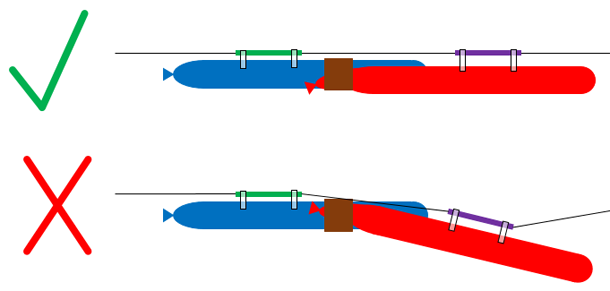 Image Credit: Ben Finio, Science Buddies / Science Buddies
Image Credit: Ben Finio, Science Buddies / Science Buddies
- Make a prediction.What do you think is going to happen when you release both nozzles of your balloons?
- Pull the balloons to one end of the line and release both nozzles.What happened? How are your two balloons similar to the two stages of a rocket? How much farther did your two-stage rocket go than it would have gone if you had had just one balloon?
Cleanup
What Happened?
You should observe that your two balloons behave like the two stages of a rocket. One balloon keeps the other balloon's nozzle pinched shut at first, preventing them both from deflating at the same time. So, that balloon deflates first—acting like the first stage of the rocket and pushing both balloons along the string. After it has deflated, the second balloon's nozzle is released, and it acts like the second stage of the rocket—continuing to move along the string while leaving the first balloon behind (as long as you didn't tape them together). Ideally this should allow the second balloon to travel farther than it could if it had to continue dragging along the weight of the first one.
As noted above, however, this can take some practice to get right. It can be difficult to get one balloon to pinch the other balloon's nozzle shut perfectly. You might accidentally have both balloons deflate at the same time. If this happens, don't get frustrated! Just like a real engineer, you can learn from your mistakes and try again. After a couple tries, especially if you have someone else to help keep the balloons pinched shut, you should be able to get your rocket working.
Digging Deeper
Imagine you are carrying a heavy backpack while hiking up a mountain. That takes a lot of energy, right? Now imagine you want to hike all the way to the mountaintop so you can see the nice view— but when you are halfway through your hike, you decide to leave your backpack, so you don't have to carry it all the way to the top. That means the second half of your hike won't require as much energy as the first half.
The same concept applies to launching rockets. It takes a great amount of energy to launch things into space. Rather than building a single, huge rocket that goes all the way into orbit, scientists and engineers have developed multistage rockets. When the first stage is done burning its fuel, it breaks away and falls back to Earth (see figure). This allows the smaller, lighter second stage of the rocket to keep going, without carrying the weight of the first stage. This approach requires less fuel overall to boost something into orbit.
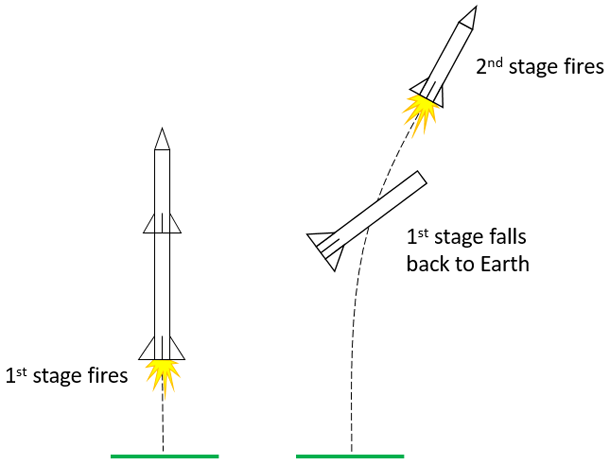 Image Credit: Ben Finio, Science Buddies / Science Buddies
Image Credit: Ben Finio, Science Buddies / Science BuddiesA two-stage rocket has two body segments that are connected to eachother. Each stage contains an engine and fuel, when the rocket initially takes off the first stage uses its fuel to propel the rocket upward. When the fuel of the first stage is depleted that section of the rocket falls away to lighten the load needed to be carried by the second stage of the rocket.
In this project you built your own two-stage rocket with balloons. When you inflated a balloon and then release the nozzle, air was pushed out the back of the balloon. According to Newton's third law of motion (for every action, there is an equal and opposite reaction), this means the balloon was pushed forward (see figure). This allowed you to make a simple (and safe!) rocket with some common household supplies.
 Image Credit: Ben Finio, Science Buddies / Science Buddies
Image Credit: Ben Finio, Science Buddies / Science Buddies
Ask an Expert
For Further Exploration
- Try adding additional balloons to make a three (or more) stage rocket.
- Try tying your string vertically instead of horizontally. How high can you get your rocket to go?
- Do a test to compare different types of rockets. What happens if you compare a two-stage rocket like the one you built to a single rocket with two balloons next to each other that deflate at the same time? Can one type go farther than the other?
Related Resources
Project Ideas
Activities
Lesson Plans
- MS-PS2-2. Plan an investigation to provide evidence that the change in an object's motion depends on the sum of the forces on the object and the mass of the object.
- MS-ETS1-3. Analyze data from tests to determine similarities and differences among several design solutions to identify the best characteristics of each that can be combined into a new solution to better meet the criteria for success.


